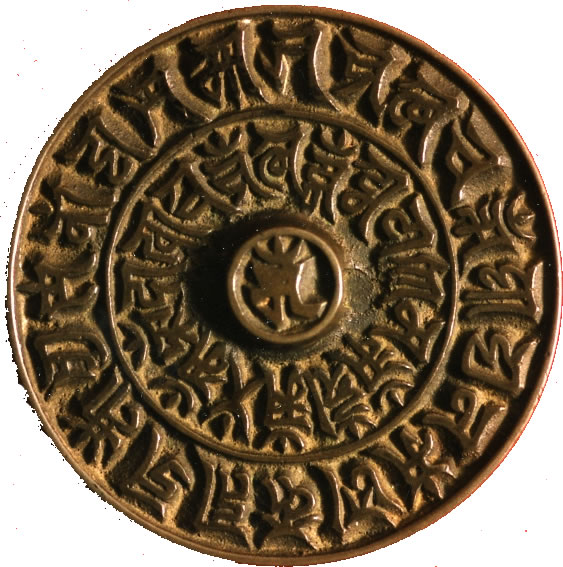Can anyone decipher the writing on this piece, which was sent in by a visitor to Omniglot?

It looks like Ranjana or another Brahmi-derived script to me.
Can anyone decipher the writing on this piece, which was sent in by a visitor to Omniglot?

It looks like Ranjana or another Brahmi-derived script to me.
It is a Chinese, or possibly a Korean, adaptation of Lantsa (which is similar to Ranjana) made to look a bit like Seal Script. Which I can read to some extent.
The central character is oṃ which can also be seen just above 3 o’clock on the outer ring.
Of the 16 characters in the inner ring (counting anti-clockwise from 6 o’clock as 1) then 3-8 are oṃ ma ṇi pa dme hūṃ – oṃ maṇipadme hūṃ – the well known mantra of Avalokiteśvara.
I think the rest might be the Cundi mantra which is popular in East Asia – it’s similar to one someone sent me: http://visiblemantra.blogspot.com/2008/09/mystery-mantra.html
Looks somewhat like Thai, actually…
On closer inspection this is what I find. It’s a series of Sanskrit mantras for the Goddess Cundi, written in a Chinese variant of Lantsa. So post 11th century, probably much later. The letter forms are quite loose so maybe the artisan couldn’t read the script but was just following a pattern.
Central character is oṃ.
inner circle 16 characters (starting from 6 o’clock = 1 going anti-clockwise):
1oṃ 2? 3oṃ 4ma 5ṇi 6pa 7dme 8hūṃ 9le 10cuṃ 11de 12svā 13hā 14? 15meṃ 16*
Outer 20 characters (same order)
1ko 2ṭī 3nāṃ 4ta 5dya 6thā 7oṃ 8ca 9le 10cu 11na 12mo 13sa 14pta 15nāṃ 16saṃ 17ya 18ksa 19bu 20ddha
Avalokiteśvara mantra inner ring 3-13. oṃ maṇipadme hūṃ
Cundi mantra outer 4-10, inner 9-13. oṃ cale cule cuṃde svāhā
Another mantra beginning ‘namo’ outer 11-20, 1-3.
The number of characters is right for the other part of the Cundi mantra: namaḥ saptānāṁ samyaksaṁbuddha koṭīnāṁ (with namo for namaḥ, but you get that). I think it must be this even though I’m not certain about the reading of some of these.
There are a couple of extra seed-syllables I’m unsure of.
c.f. http://cundimantra.weebly.com/index.html which shows (reading clockwise in this case) the same thing all in one circle including the Avalokiteśvara mantra. Note the similarity of the script in the image on this page.
My one good source on this script is: Tatsuon Maruyama. Sanskrit-Japanese dictionary of dharanis: The Darani-jiten (Sata-pitaka series : Indo-Asian literatures) International Academy of Indian Culture, 1981. Pg. 48ff. has a syllabary comparing this variation Lantsa to Chinese Siddham with Chinese commentary. A late introduction into East Asia; post 11th century when the script was invented, so probably introduced by Tibetan/Mongolian Buddhists.
Best Wishes
Jayarava
http://www.visiblemantra.org
Thai is ultimately a Brahmi-derived script, but those characters don’t resemble Thai (or Lao, etc) in the slightest.
It doesn’t look like Thai at all. Thai has very few crossing and angular strokes. Thai’s primary characteristic are rather open, rounded characters and rounded “heads”. This script is angular and full of crossing lines.
Relax, guys. Jayarava solved all the mystery. There’s no reason to continue discussion about what it might be.
omg this is deffintly brahmi derived, most of the letters look the same as Bengali! For Te letter in the top left cornish looks like:
ঘ which is gh in Bengali, down from that letter looks like না which is na in bengali. Also in the second inner circle i see a letter that looks লা
which is laa in Bengali. So im pretty sure this is Brahmi